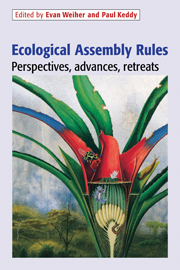Book contents
- Frontmatter
- Contents
- List of Contributors
- Introduction: The scope and goals of research on assembly rules
- Part I The search for meaningful patterns in species assemblages
- 1 The genesis and development of guild assembly rules
- 2 Ruling out a community assembly rule: the method of favored states
- 3 Community structure and assembly rules: confronting conceptual and statistical issues with data on desert rodents
- 4 Introduced avifaunas as natural experiments in community assembly
- 5 Assembly rules in plant communities
- 6 Assembly rules at different scales in plant and bird communities
- 7 Impact of language, history and choice of system on the study of assembly rules
- Part II Other perspectives on community assembly
- Index
4 - Introduced avifaunas as natural experiments in community assembly
Published online by Cambridge University Press: 04 September 2009
- Frontmatter
- Contents
- List of Contributors
- Introduction: The scope and goals of research on assembly rules
- Part I The search for meaningful patterns in species assemblages
- 1 The genesis and development of guild assembly rules
- 2 Ruling out a community assembly rule: the method of favored states
- 3 Community structure and assembly rules: confronting conceptual and statistical issues with data on desert rodents
- 4 Introduced avifaunas as natural experiments in community assembly
- 5 Assembly rules in plant communities
- 6 Assembly rules at different scales in plant and bird communities
- 7 Impact of language, history and choice of system on the study of assembly rules
- Part II Other perspectives on community assembly
- Index
Summary
Introduction
In 1975, Jared Diamond hypothesized a series of rules for assembling communities of birds on islands in the south Pacific. In large part, these rules were based on incidence functions that dealt with the probability of species occurrence as a function of species richness (Diamond, 1975). His work sparked a heated debate and the concept of ‘assembly rules’ was largely put to rest (Connor & Simberloff 1979; Gilpin & Diamond, 1982). Perhaps one of the most serious, and yet least appreciated, problems with applications of assembly rules is that they are, in practice, based principally, if not exclusively, on extant community membership (e.g., Wilson & Roxburgh, 1994; Fox & Brown, 1993). As Diamond (1975) noted, the principal goal in elucidating assembly rules is to discover why some species become members of a community and some do not. How can the true criteria for inclusion in a community be decided without knowledge of criteria for rejection?
In order to derive meaningful assembly rules, one must begin with knowledge of all species once present, but now missing, from communities. In natural communities, a knowledge of this depth is generally lacking, reducing the strength of tests for assembly rules. Communities of non-indigenous bird species represent a companion system in which to study the effects of various selection criteria for community membership. Within such communities there is often a very thorough knowledge of which species failed to become community members enabling evaluation of the influence of specific mechanisms of membership rejection.
- Type
- Chapter
- Information
- Ecological Assembly RulesPerspectives, Advances, Retreats, pp. 108 - 129Publisher: Cambridge University PressPrint publication year: 1999
- 11
- Cited by

